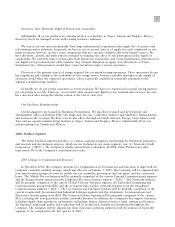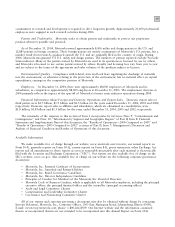Motorola 2004 Annual Report Download - page 23
Download and view the complete annual report
Please find page 23 of the 2004 Motorola annual report below. You can navigate through the pages in the report by either clicking on the pages listed below, or by using the keyword search tool below to find specific information within the annual report.
15
Our Strategy
We continue to focus on our strategy to innovate and enhance our end-to-end network portfolio. We are
focused on accelerating the rate of digital penetration by broadband operators in North America through the
introduction of an enhanced suite of digital set-top terminals, including more cost-eÅective products designed to
increase the number of set-tops per household, as well as higher-end products for premium service, including
HDTV and DVR applications. We also continue to focus on opportunities in regions outside of North America,
including the development of digital video products designed to be compliant with technology required in these
regions.
We are focused on enhancing and expanding our infrastructure oÅerings, including next-generation products in
the CMTS and Ñber optic network markets. Sales of our CMTS infrastructure products increased in 2004 and are
expected to continue to increase in 2005 as cable operators build out their networks to accommodate enhanced
data and voice over IP applications. We also will continue to expand our portfolio of data products beyond the
traditional cable modem business and into voice modems. We are focused on providing home networking and
monitoring products, including wireless networking devices with high-speed Internet access for a complete home,
small oÇce or small-to-medium enterprise communications system.
Customers
We are dependent upon a small number of customers for a signiÑcant portion of our sales. The vast majority
of our sales are in the U.S.Ìwhere a small number of large cable television multiple system operators (MSOs) own
a large portion of the cable systems and account for a signiÑcant portion of the total capital spending in the
industry. Comcast Corporation accounted for approximately 30% of the segment's net sales in 2004. The loss of
business in the future from Comcast or any of the other major MSOs could have a material adverse eÅect on the
segment's business.
Competition
The businesses in which we operate are highly competitive. The rapid technological changes occurring in each
of the markets in which we compete are expected to lead to the entry of many new competitors.
We compete worldwide in the market for digital set-top terminals for broadband and satellite networks. Based
on 2004 annual sales, we believe we are the leading provider of digital cable set-top terminals in North America.
Our digital cable set-top terminals compete with products from a number of diÅerent companies, including:
(i) those that develop and sell substitute products that are distributed by direct broadcast satellite (DBS) service
providers through retail channels, (ii) those that develop, manufacture and sell products of their own design, and
(iii) those that license technology from us or other competitors. In North America, our largest competitor is
ScientiÑc-Atlanta. Other competitors in North America include Cisco, Arris, and C-COR. Outside of North
America, where we have a smaller market position, we compete with many equipment suppliers, including several
consumer electronics companies.
The traditional competitive environment in the North American cable market continues to change for several
reasons. First, based on our customers' requirements, we have begun and will continue to license certain of our
technology to certain competitors. In 2005, we expect to license our technology to more licensees, which may
result in increased competition for sales of digital set-top terminals in our markets. Second, per OpenCable
speciÑcations, televisions were introduced in 2004 that will no longer require a digital set-top box for one-way
broadcast digital services. Future versions of this speciÑcation will enable similar devices to access pay-per-view and
VOD applications without a set-top box. The FCC also has mandated that digital tuners be incorporated into all
television sets sold in the U.S. by 2006. Television manufacturers are expected to integrate technology that is
available in our set-top terminals into their products in the future and bypass the need for a set-top terminal for
certain applications.
Historically, reception of digital television programming from the cable broadband network required a set-top
terminal with security technology that was compatible with the network. This security technology has limited the
availability of set-top terminals to those manufactured by a few cable network manufacturers, including Motorola.
The FCC has enacted regulations requiring separation of security functionality from set-top terminals by July 1,
2006. To meet this requirement, we have developed security modules for sale to cable operators for use with our
own and third-party set-top terminals. As a step towards this implementation, in 2002, the cable industry and
























